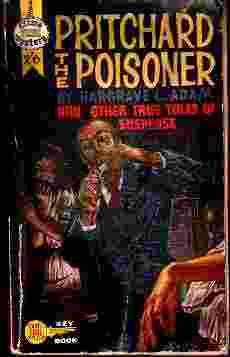The Regrettable Dr. Edward William Pritchard ![images[2].jpg](/website/B82037/files/images[2].jpg)
Terrible things happen in the world. To progress, we must tell the story, and reflect and learn from them.
Dr Edward William Pritchard Physician and Man Midwife. He lived in Hunmanby with his wife and mother in law. Before the railway arrived, Filey was a small collection of fishermen’s hovels, and Hunmanby was the main town.
Dr Pritchard was born around 1825. He had a series of somewhat questionable medical qualifications possibly from Leyden University. He was given a commission as naval assistant surgeon in 1846 and served on the Victory in it's final days. Four years later Pritchard married Mary Jane Taylor. In 1851 he resigned from the Navy and took up a position as GP in Hunmanby.
On moving to the area, he was appointed Medical Officer to Bridlington Number 3 Area, covering the area from Thwing to Folkton and Filey. He opened surgeries in Filey and in Hunmanby on Cross Hill, near to the entrance to Hunmanby Hall; he also took a surgery in Bridlington, opposite to the old Lloyd Hospital. He later moved to Warbuton House, on the corner of Hungate Lane, opposite what is now the Co-Op.
Allegedly, he would ride outside church on a Sunday, horse whipping his "heart sink" patients. His groom would call him from church services, and he would disturb the proceedings by riding dramatically and noisily away. Though he looked the part of a respectable family man, he was, biographies tell us, an utterly weak character, a joke among his colleagues because of his incredible boasting and lying. He also regarded himself as a great lover.
He despised life as a country doctor, and moved back to his alma mater in Glasgow in Berkeley Terrace in 1860.
In 1863, when he was 38, a fire broke out in the room of the servant girl in his house; she was found dead, and it seemed clear that she had made no attempt to leave her bed during the fire. Pritchard was widely suspected, but he nevertheless won a claim from an insurance company.
In 1864, he made another servant girl - aged 15 - pregnant, and promised the fifteen-year-old girl that, should his wife die, he would marry her. On the strength of this promise he carried out an abortion on the girl.
In November, 1864, his wife Mary  became ill, with vomiting and dizziness. A doctor called in by Pritchard suspected she was being poisoned, and wrote to Mary Pritchard's brother, suggesting she should be moved into hospital. The result was that Mary Pritchard's mother, Mrs. Taylor, decided to come and nurse her daughter. Soon, Mrs. Taylor was suffering from the same symptoms. Mary died on February 24, 1865, and Mrs. Pritchard followed her a month later. Pritchard provided both death certificates, stating that Mrs. Taylor died of apoplexy, and his wife of gastric fever.
became ill, with vomiting and dizziness. A doctor called in by Pritchard suspected she was being poisoned, and wrote to Mary Pritchard's brother, suggesting she should be moved into hospital. The result was that Mary Pritchard's mother, Mrs. Taylor, decided to come and nurse her daughter. Soon, Mrs. Taylor was suffering from the same symptoms. Mary died on February 24, 1865, and Mrs. Pritchard followed her a month later. Pritchard provided both death certificates, stating that Mrs. Taylor died of apoplexy, and his wife of gastric fever.
The Procurator-Fiscal received an anonymous letter which made certain allegations against the doctor and the bodies were exhumed. On examination, it was found that both of the women had died of antimony poisoning. Pritchard was arrested and charged with murder. His trial took place in Edinburgh in July 1865. The circumstantial evidence was overwhelming and he was duly found guilty.
Pritchard was hanged in public, the last person to be publicly executed in Glasgow. The attendance for his demise was estimated at over 100,000.
 Several books were subsequently written about his exploits, establishing his notoriety to the Victorians and Edwardians.
Several books were subsequently written about his exploits, establishing his notoriety to the Victorians and Edwardians.
Mr Mowthorpe tells of the final indignity; when he first went to the Royal Masonic Lodge in Filey in the 1960s, there was a blank space on the Honours Board where Pritchard’s name had been expunged.
![images[9].jpg](/website/B82037/files/images[9].jpg) Happy Families- The Pritchards at Home
Happy Families- The Pritchards at Home